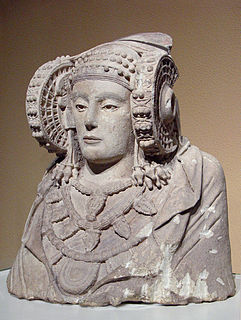 W
WThe Baalshillem Temple Boy, or Ba'al Sillem Temple Boy, is a votive statue of a "temple boy" with a Phoenician inscription known as KAI 281. It was found along with a number of other votive statues of children near the canal in the Temple of Eshmun in 1963-64 by Maurice Dunand, and is currently in the National Museum of Beirut. The inscription mentions four previously unknown names of Kings of Sidon, which correspond exactly with those from known Sidonian coins. The inscription has been translated as follows:This statue that Baalshillem, son of King Ba'na, king of the Sidonians, son of King Abdamun, king of the Sidonians, son of King Baalshillem, king of the Sidonians, gave to his lord Eshmun at the "Ydll"-Spring. May he bless him.
 W
WThe Byblos figurines or Phoenician statuettes are approximately 1,500–2,000 ex-voto statuettes found in ancient Phoenician temples in Lebanon, primarily in Byblos, but also in Kamid al lawz. The statuettes date to the second millennium BC and are made of bronze, silver, or copper alloy. The Byblos figurines are considered to represent the best example of their kind across the Levant.
 W
WThe Lady of Baza is a famous example of Iberian sculpture by the Bastetani. It is a limestone female figure with traces of painted detail in a stuccoed surface that was found on July 22, 1971, by Francisco José Presedo Velo, at Baza, in the Altiplano de Granada, the high tableland in the northeast of the province of Granada. The town of Baza was the site of the Ibero-Roman city of Basti and, in one of its two necropoleis, the Cerro del Santuario, the Lady of Baza was recovered. She is seated in an armchair, and an open space on the side is thought to have contained ashes from a cremation.
 W
WLady of Cerro de los Santos, also known as Gran Dama Oferente, is an Iberian sculpture from the 2nd century BCE, that is now in National Archaeological Museum in Madrid.
 W
WThe Lady of Elx or Lady of Elche is a limestone bust that was discovered in 1897, at La Alcudia, an archaeological site on a private estate two kilometers south of Elche, Spain. It is currently exhibited in the National Archaeological Museum of Spain in Madrid.
 W
WLady of Galera is an alabaster female figurine, made in the 7th century BC, that probably represents the Near Eastern goddess Astarte. It is at the National Archaeological Museum of Spain, in Madrid.
 W
WLady of Guardamar, is a limestone female bust, 50 cm high, dated circa 400 BCE, that was discovered in fragments in the Phoenician archaeological site of Cabezo Lucero in Guardamar del Segura in Alicante province, Spain, on September 22, 1987.
 W
WThe Thrones of Astarte are approximately a dozen ex-voto "cherubim" thrones found in ancient Phoenician temples in Lebanon, in particular in areas around Sidon, Tyre and Umm al-Amad. Many of the thrones have a similar style, with cherubim heads on winged lion bodies on either side. Images of the thrones are found in Phoenician sites around the Mediterranean, including an ivory plaque from Tel Megiddo (Israel), a relief from Hadrumetum (Tunisia) and a scarab from Tharros (Italy).